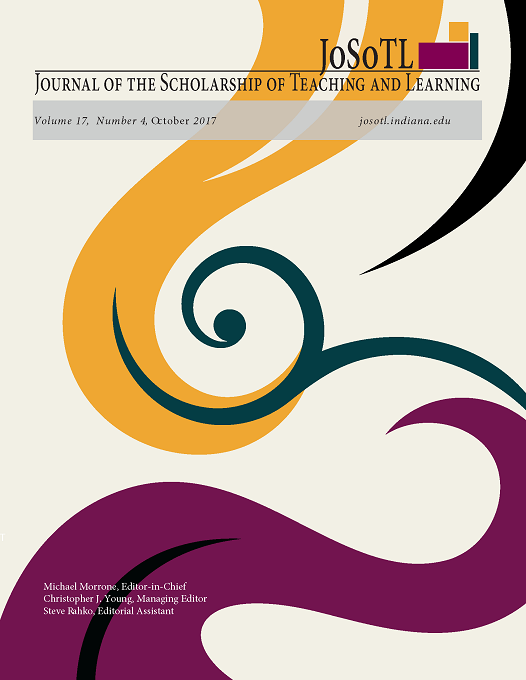Getting an Honest Answer: Clickers in the Classroom
Main Article Content
Abstract
Downloads
Article Details
- Authors retain copyright and grant the Journal of the Scholarship of Teaching and Learning (JoSoTL) right of first publication with the work simultaneously licensed under a Creative Commons Attribution License, (CC-BY) 4.0 International, allowing others to share the work with proper acknowledgement and citation of the work's authorship and initial publication in the Journal of the Scholarship of Teaching and Learning.
- Authors are able to enter separate, additional contractual agreements for the non-exclusive distribution of the journal's published version of the work (e.g., post it to an institutional repository or publish it in a book), with an acknowledgement of its initial publication in the Journal of the Scholarship of Teaching and Learning.
- In pursuit of manuscripts of the highest quality, multiple opportunities for mentoring, and greater reach and citation of JoSoTL publications, JoSoTL encourages authors to share their drafts to seek feedback from relevant communities unless the manuscript is already under review or in the publication queue after being accepted. In other words, to be eligible for publication in JoSoTL, manuscripts should not be shared publicly (e.g., online), while under review (after being initially submitted, or after being revised and resubmitted for reconsideration), or upon notice of acceptance and before publication. Once published, authors are strongly encouraged to share the published version widely, with an acknowledgement of its initial publication in the Journal of the Scholarship of Teaching and Learning.
References
Abrahamson, L. (2006). A brief history of networked classrooms: Effects, cases, pedagogy, and implications. In D. A. Banks (Ed.), Audience response systems in higher education (pp. 1–25). Hershey, PA: Information Science Publishing. https://doi.org/10.4018/978-1-59140-947-2
Ainsworth, S., Gelmini-Hornsby, G., Threapleton, K., Crook, C., O’Malley, C., and Buda, M. (2011). Anonymity in classroom voting and debating. Learning and Instruction, 21(3), 365-378. https://doi.org/10.1016/j.learninstruc.2010.05.001
Bruff, Derek. (2009). Teaching with classroom response systems: Creating active learning environments. San Francisco, CA: Jossey-Bass.
Crouch, C. H., and Mazur, E. (2001). Peer instruction: Ten years of experience and results. American Journal of Physics, 69(9), 970–977. https://doi.org/10.1119/1.1374249
Draper, S. W., and Brown, M. I. (2004). Increasing interactivity in lectures using an electronic voting system. Journal of Computer Assisted Learning, 20(2), 81–94. https://doi.org/10.1111/j.1365-2729.2004.00074.x
Fies, C., and Marshall, J. (2006). Classroom response systems: A review of the literature. Journal of Science Education and Technology, 15(1), 101-109. https://doi.org/10.1007/s10956-006-03601
Kay, R. and LeSage, A. (2009). Examining the benefits and challenges of using audience response systems: A review of the literature. Computers and Education, 53, 819-827. https://doi.org/10.1016/j.compedu.2009.05.001
Kennedy, G. E., and Cutts, Q. I. (2005). The association between students’ use of electronic voting systems and their learning outcomes. Journal of Computer Assisted Learning, 21(4), 260–268. https://doi.org/10.1111/j.1365-2729.2005.00133.x
Latessa, R., and Mouw, D. (2005). Use of audience response system to augment interactive learning. Family Medicine, 37(I), 12–14.
Lorenz, J., Rauhut, H., Schweitzer, F., and Helbing, D. (2011). How social influence can undermine the wisdom of crowd effect. Proceedings of the National Academy of Sciences, 108(22), 9020-9025. https://doi.org/10.1073/pnas.1008636108
Mayer, R. E. (2001). Multimedia learning. New York: Cambridge University Press.
Mayer, R. E. (2008). Learning and instruction. New York: Pearson Merrill Prentice Hall.
Mayer, R. E., and Wittrock, M. C. (2006). Problem solving. In P. A. Alexander and P. H. Winne (Eds.), Handbook of educational psychology: Second edition (pp. 287–304). Mahwah, NJ: Erlbaum.
Powell, S., Straub, C., Rodriguez, J., and VanHorn, B. (2011). Using clickers in large college psychology classes: Academic achievement and perceptions. Journal of the Scholarship of Teaching and Learning, 11(4), 1–11.
Preszler, R. W., Dawe, A., Shuster, C. B., and Shuster, M. (2007). Assessment of the effects of student response systems on student learning and attitudes over a broad range of biology courses. CBE-Life Sciences Education, 6(1), 29–41. https://doi.org/10.1187/cbe.06-09-0190
Roschelle, J., Abrahamson, L., and Penuel, W. (2004). Integrating classroom network technology and learning theory to improve classroom science learning: A literature synthesis. Paper presented at the Annual Meeting of the American Educational Research Association, San Diego, CA.
Shapiro, A. (2009). An empirical study of personal response technology for improving attendance and learning in a large class. Journal of the Scholarship of Teaching and Learning, 9(1), 13–26.
Siau, K., Sheng, H., and Nah, F. (2006). Use of classroom response system to enhance classroom interactivity. IEEE Transactions on Education, 49(3), 398–403. https://doi.org/10.1109/TE.2006.879802
Simpson,V. and Oliver, M. (2007). Electronic voting systems for lectures then and now: A comparison of research and practice. Australasian Journal of Educational Technology, 23(2), 187– 208. https://doi.org/10.14742/ajet.1264
Stowell, J. R., Oldham, T., and Bennett, D. (2010). Using student response systems (“clickers”) to combat conformity and shyness. Teaching of Psychology, 37(2), 135–140. https://doi.org/10.1080/00986281003626631
Wittrock, M. C. (1990). Generative processes of comprehension. Educational Psychologist, 24, 354–376. https://doi.org/10.1207/s15326985ep2404_2
